I’m only a hem away from finishing a pair of high waisted, wool trousers from the fabulous Patrones 272:
I’ll leave the fine details for the final photoshoot and review, but I’m just so proud of my very first welt pockets. Progress on my wool coat has been stalled for the last few months because the thought of doing the bound buttonholes has just intimidated and overwhelmed me, so I thought I’d make my first attempts at welt pockets first since they’re essentially the same thing, but on a less tiny (and fiddly) scale.
There are tons of instructions on the internet for welt pockets, but I used the supplemental instructions from the Aug 2008 BWOF since I could just have it lying open on my ironing board as I worked. The diagrams were particularly useful, and I think my first attempts turned out great!
The orange thread is just the basting stitches – it’s just to keep the pockets closed as I finished the construction of the rest of the trousers and they’ll get removed in the final stages. As you can see, I’ve also moved the welt pockets from the front waistband (which just seems like a weird place for them!) to the back.
This is also my first time lining a pair of trousers (though here I opted to only line the legs to the knee). For this I used Cupro lining, which I’d never used or even heard of before, so I solicited help from the Pattern Review boards on how to use it. If you don’t fancy reading through the whole thread, the gist of it is that it’s a nice lining, but the process to make it is really toxic and therefore really brings out my eco-guilt. So I’ll be sure to make excellent use of what I have since it’s already been made…
Definition:
Cupro is the European cousin of tencel, and it is a bit difficult to find a lot of information on this fabric. Cupro is somewhat similar to rayon in that it is reprocessed cellulose, but cupro is much more like tencel: Please see the Tencel main page for general information on this fiber.
Cupro gets its name from cuprammonium that is used to process the wood pulp or cotton linters that are the base material for cupro. Like tencel, the base material for cupro is a regenerated cellulose fiber, and the fabric breathes like cotton, drapes beautifully, and feels like silk on your skin. An elegant fabric.
Cupro is not synthetic, nor is it a man-made fabric. It is considered a regenerated fabric, in other words, it is reclaimed from natural products.
MacCulloch and Wallis stock cupro, though mine is from myfabrics.co.uk, whom I do not recommend buying from. It feels really nice, especially after I pre-washed it – it’s very cool against the skin and very close to silk in feel and drape. It also breathes, unlike synthetics, which is really important to me since it’ll be against the skin and the outer layer is breathable stretch wool. I have a feeling the cupro will be perfect in keeping these trousers from wrinkling from wear throughout the day.
Barring any Christmas party mishaps, these should be hemmed and ready to show off by the weekend. But the question remains – what to wear to Christmas dinner – these trousers, or the blue silk dress?



